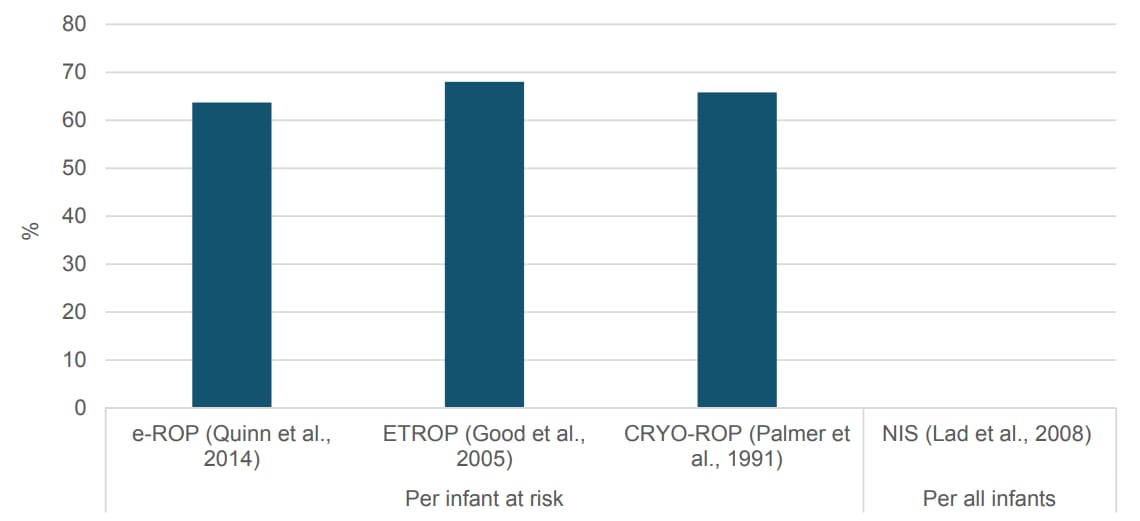Review: Retinopathy of Prematurity
‹View Table of Contents
The VEHSS team conducted a review of published literature on examination-based population studies reporting the prevalence of retinopathy of prematurity.
Retinopathy of prematurity (ROP) is a proliferative condition of the retinal vasculature that primarily affects premature infants and is a leading cause of visual impairment and blindness among infants.(Lad, 2008; NEI, 2015) Infants with a birth weight (BW) of less than 1,250 grams and/or those with a gestational age of 31 weeks or less are particularly at risk. The development of ROP is due to abnormal retinal development likely tied to varying levels of oxygenation experienced by infants after birth. There are five categorizations of ROP, ranging from mild to severe. Stage I and II involve mild and moderate abnormal vascular growth in the retina that can resolve without treatment and without subsequent vision impairment in most cases. Stage III is distinguished by severely abnormal vascular growth in the retina, in which vessels grow toward the center of the eye rather than along the surface of the retina. Some infants in stage II are considered to have “plus disease,” characterized by enlarged or contorted vessels. In Stages IV, abnormal vessels cause the retina to become partially detached, and in Stage V, abnormal vessels cause complete retinal detachment. An assessment of which zone of the eye is affected in conjunction with time spent at each stage is used to gauge the severity of the disease.(Quinn, 2016)
Download the full report:
Published Examination-Based Prevalence of Major Eye Disorders[PDF – 703 KB]
Retinopathy of Prematurity Literature Review Results
There were four studies that published prevalence estimates for ROP from 1991 to 2016.
Table 1. Retinopathy of Prematurity Prevalence Sources.
| Author | Date of Publication | Title | Date of Data Collection | Data Source | Sample Size |
|---|---|---|---|---|---|
| Quinn GE, Barr C, et al. | 2016 | Changes in Course of Retinopathy of Prematurity from 1986 to 2013: Comparison of Three Studies in the United States | 1986–2013 | CRYO-ROP, ETROP, e-ROP | 4,099; 6,998; 1,284 |
| Quinn, GE, et al. | 2014 | Telemedicine Approaches to Evaluating Acute-Phase Retinopathy of Prematurity: Study Design | 2011–2013 | e-ROP | 1,284 |
| Lad EM, Nguyen TC, et al. | 2008 | Retinopathy of Prematurity in the United States | 1997–2002 | NIS | 22,939,000 |
| Good WV, Hardy RJ, et al. | 2005 | The Incidence and Course of Retinopathy of Prematurity: Findings from the Early Treatment for Retinopathy of Prematurity Study | 2000–2002 | ETROP | 6,998 |
| Palmer EA, Flynn JT, et al. | 1991 | Incidence and Early Course of Retinopathy of Prematurity. The Cryotherapy for Retinopathy of Prematurity Cooperative Group | 1986–1987 | CRYO-ROP | 4,099 |
Overall Retinopathy of Prematurity (ROP) Prevalence Rates
Figure 1 below shows prevalence estimates from the four selected studies. Estimates varied from 0.12% reported by Lad et al. (2008) to 68% reported by Good et al. (2005). The estimate reported by Lad et al. (2008) is based on the entire sample of newborns, whereas the estimates reported by Quinn et al. (2004), Good et al. (2005), and Palmer et al. (1991) are based on a high-risk population. The CRYO-ROP, ETROP and e-ROP studies determined the incidence of ROP by using ophthalmologists to diagnose infants enrolled in the respective study. These literature review results demonstrate the lack of data available on the burden of ROP among the general population and among different socioeconomic and demographic groups.
